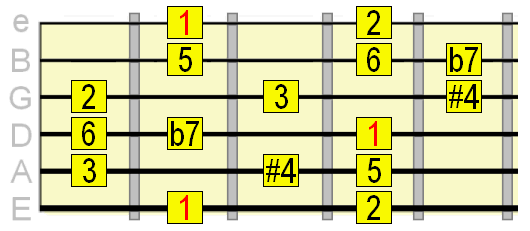Home › Q&A
Funk Guitar Scales and Licks
Question by Tom
(Leeds)
For the song Sex Machine in E7/9 which scales would you use and can you show how to apply them in audio examples?
Generally when playing quick in 16th note timing I always tend to lose the plectrum. Do you hold the pick really tightly or what can be done to avoid this from happening?
Cheers
Tom
Scales & Licks for Funk Soloing
Ah, this one never gets old...The original is actually in Eb, so Jimmy Nolen is playing an Eb9 chord for the first section.
When thinking about scales, approach it just like you would the I chord in major key blues.
So the most obvious choice is to use minor pentatonic and its blues variation (minor pentatonic with a b5) as a base for your solo.
Over Eb9, we'll be positioning this at the 11th fret...

Combine this with the tones from major pentatonic in the same position (so the 1 note is again at the 11th fret) and you have a good pot of tones around which to build your funky phrases...

Let's look at funky ways in which we could combine these two scales.
If you skip to 1:03 on the original track, you can hear the keys playing a nifty little pentatonic-led phrase.
You can create something similar on guitar using double stops (click the tabs to hear examples)...

Also try adding in the major 3rd occasionally...

Note: I have a lesson on using minor and major pentatonic together that you might find useful.
Another major/minor combo that makes use of that bluesy b5 tone...

What's interesting is you could also approach this Eb9 chord as if it were the IV chord.
All this means is we play minor (just minor this time) pentatonic on the root of Bb, an interval of a perfect 5th below Eb. That's the 6th fret.
If you visualise the Eb9 chord, here's how the pattern would look in relation to that chord position...


We can use the same b5 variation in this position...

Now for something a little jazzier...
To get more of an "outside" sound, try using Lydian dominant in the root (Eb) position, which is basically the Mixolydian scale with a #4...

This should give you some more unpredictable variations over dominant 7th and 9th chords...

16th Note Funk Picking
You mentioned losing the pick when playing 16th notes. This used to happen to me a lot and there were two solutions for this:1) Get a lighter pick. I now use .46mm (very light by most players' standards). I find the lighter picks flex over the strings with less obstruction, so there's less chance of jolting the pick out of your fingers.
The only drawback is you lose a bit of that biting tone you get with thicker picks, but it's a reasonable trade off.
2) Use a pick with some kind of grip. Dunlop picks do the job for me, as the raised writing and mesh provide extra grip.
Before I was using a very smooth plastic pick, but switching to a nylon pick with raised grip helped tremendously.
Share Your Comments
|
||
|
||
|
||